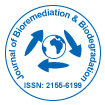Research Article
Biodegradation and Decolorization of Reactive Orange 16 by Nocardiopsis alba Soil Isolate
| Sugumar Shobana1* and Berla Thangam E2 | |
| 1Department of Bioinformatics, School of Bioengineering, SRM University, Kattankulathur 603203, India | |
| 2Department of Biotechnology, School of Bioengineering, SRM University, Kattankulathur 603203, India | |
| Corresponding Author : | Shobana Sugumar Department of Bioinformatics School of Bioengineering SRM University, Kattankulathur 603203, India E-mail: ksemaa@gmail.com |
| Received April 30, 2012; Accepted June 04, 2012; Published June 06, 2012 | |
| Citation: Shobana S, Thangam EB (2012) Biodegradation and Decolorization of Reactive Orange 16 by Nocardiopsis alba Soil Isolate. J Bioremed Biodeg 3:155. doi:10.4172/2155-6199.1000155 | |
| Copyright: © 2012 Shobana S, et al. This is an open-a ccess article distributed under the terms of the Creative Commons Attribution License, which permits unrestricted use, distribution, and reproduction in any medium, provided the original author and source are credited. | |
Related article at Pubmed Pubmed  Scholar Google Scholar Google |
|
Abstract
A bacterium identified as Nocardiopsis alba was isolated from acclimated sludge from a dyeing wastewater treatment plant. This strain rapidly decolorized Reactive orange16 (RO16) at 0.1% (w/v) concentration of both sucrose and peptone supplemented in Mineral Salt Medium (MSM) under static conditions at a temperature of 30°C with in 24 h with an initial dye concentration of 100 mg/L. The organism exhibited a remarkable color removal capability (95%) even at a high concentration of 1000 mg/L (RO16) dye within 24 h. The biodegradation products were analyzed by, FTIR spectroscopy and LC-MS analysis. The LC-MS analysis indicated the presence of 1-amino- 1-napthalene sulphonic acid in degraded product of the dye. The degraded product is less toxic to the growth of Vigna mungo seeds when compared to the non degraded dye.

 Spanish
Spanish  Chinese
Chinese  Russian
Russian  German
German  French
French  Japanese
Japanese  Portuguese
Portuguese  Hindi
Hindi 
